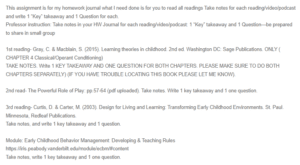Classical and Operant Conditioning, Play-based learning, and Visual arts
First Reading
Notes: Classical and Operant Conditioning: The Early Years Experience
- Classical conditioning entails the association between an involuntary response and a stimulus, while operant conditioning is about associating a voluntary behavior with the outcome or consequence (Gray & MacBlain, 2015).
- Classical conditioning emphasizes the importance of cultivating a suitable environment for learning.
- Teachers should cultivate a positive classroom environment to help learners overcome anxiety and fear.
- When students find the learning environment enticing, they learn new associations, which help in boosting their performance.
- In operant conditioning, behavior is shaped and maintained based on the consequences.
- Skinner believed that lousy behavior is discouraged based on the consequences, such as punishment.
- Positive rewards encourage good behavior.
Takeaway
A fear response and phobias are examples of classical conditioning; when children develop a fear response towards specific stimuli, they tend to dissociate themselves from the learning environment, hence poor performance.
Question
How can a teacher apply classical and operant conditioning to improve students’ ability to learn new concepts?
Second Reading
Notes
- Play-based learning focuses on helping children build on their image, hence improving their self-esteem based on their varied cultures and expectations (California Department of Education, 2021).
- The image of a child is influenced by their social connections, family beliefs, and the cultural and historical background of their communities (California Department of Education, 2021).
- The image that adults bring to the learning environment influences how they treat children and design the learning environment.
- How a teacher treats a child determines the image a child will have as they grow up.
- It is essential to treat children well because it will impact how they view themselves for the rest of their lives.
Takeaway
Teachers should have an understanding of various approaches to the world. This is important because it helps to inculcate varied ideas, perspectives, and possibilities in the learners, bringing up a person willing to embrace diversities.
Question
Does the image that a teacher has towards a particular child make them assume that every child is strong and capable?
Third Reading
Notes
- Visual arts encompass a wide range of visual modes that children use to express and communicate, thus helping to mediate their thinking.
- Visual arts help children understand basic skills like reading and writing, which are fundamental skills needed daily (Curtis & Carter,2003).
- Incorporating symbolic representations and visual arts in the curriculum helps children enter the imaginative world and enhance their creativity as they engage their playful thinking skills.
- Symbolic presentations help children develop their cultural knowledge, fostering identity formation.
Takeaway
Before incorporating symbolic presentation and visual arts into the curriculum, teachers should build on their confidence in planning and implementing such a curriculum.
Question
Why is the teacher’s role significant in supporting and facilitating the visual arts experiences of learners?
Fourth Reading
Notes
- Childhood behavior management means teaching children values and behaviors acceptable in the classroom (Gettinger & Fischer, 2014).
- Establishing clear rules helps in managing the behavior of learners.
- Learning positive behavior is one of the developmental outcomes that children must achieve during their early learning.
- Teachers should set clear behavior expectations by ensuring they are specific, observable, and measurable.
Takeaway
Good conduct does not happen in a vacuum but in an organized, harmonious classroom environment.
Question
Why is having a strict childhood moral management strategy important in encouraging good behavior and discouraging bad ones?
References
California Department of Education. (2021). The powerful role of play in early education (T. Wyant & L. Bridges-Nieuwenhuyse, Eds.). Department of Education.
Curtis, D. & Carter, M. (2003). Design of living and learning: Transforming early childhood environments. St. Paul. Minnesota, Redleaf Publications.
Gettinger, M., & Fischer, C. (2014). Early childhood Behavior management: Developing & Teaching Rules. Handbook of classroom management (pp. 141–166). Routledge.
Gray, C., & MacBlain, S. (2015). Learning theories in childhood (2nd ed.). Sage Publications.
ORDER A PLAGIARISM-FREE PAPER HERE
We’ll write everything from scratch
Question 

Classical and Operant Conditioning
This assignment is for my homework journal what I need done is for you to read all readings Take notes for each reading/video/podcast and write 1 “Key” takeaway and 1 Question for each.
Professor instruction: Take notes in your HW Journal for each reading/video/podcast: 1 “Key” takeaway and 1 Question—be prepared to share in small group
1st reading- Gray, C. & Macblain, S. (2015). Learning theories in childhood. 2nd ed. Washington DC: Sage Publications. ONLY ( CHAPTER 4 Classical/Operant Conditioning)
TAKE NOTES. Write 1 KEY TAKEAWAY AND ONE QUESTION FOR BOTH CHAPTERS. PLEASE MAKE SURE TO DO BOTH CHAPTERS SEPARATELY) (IF YOU HAVE TROUBLE LOCATING THIS BOOK PLEASE LET ME KNOW).
2nd read- The Powerful Role of Play: pp.57-64 (pdf uploaded). Take notes. Write 1 key takeaway and 1 one question.
3rd reading- Curtis, D. & Carter, M. (2003). Design for Living and Learning: Transforming Early Childhood Environments. St. Paul. Minnesota, Redleaf Publications.
Take notes, and write 1 key takeaway and 1 question.
Module: Early Childhood Behavior Management: Developing & Teaching Rules
Early Childhood Behavior Management: Developing and Teaching Rules
Take notes, write 1 key takeaway and 1 one question.